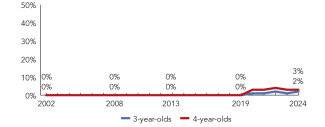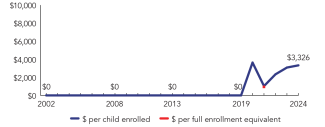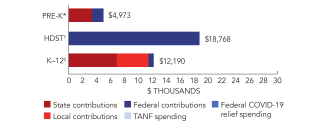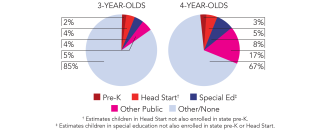
State of Preschool
Access Rankings
Resource Rankings
Total Benchmarks Met
Overview

During the 2023-2024 school year, Utah preschool programs enrolled 2,011 children, an increase of 24 from the prior year. State spending totaled $6,688,608, up $564,135 (9%), adjusted for inflation, since last year. State spending per child equaled $3,326 in 2023-2024, up $244 from 2022-2023, adjusted for inflation. Utah met 6 of 10 quality standards benchmarks.
What's New

In the 2024 state legislative session, the legislature approved an amendment to the School Readiness (SR) Program that abolished the SR Board and created a school readiness team comprised of staff from the Department of Workforce Services, Office of Child Care and staff from the Utah State Board of Education (USBE) to fulfill certain duties regarding the SR Programs. This change will streamline program decisions, allowing greater flexibility and responsiveness to the needs of program grantees.
The 2024 legislation also expanded the eligibility requirements for SR grant funding for children who are economically disadvantaged or have experienced at least one risk factor instead of both. Programs are still expected to prioritize the most at-risk children, but the change expands access to more families. However, since no new funding was allocated for the program, fewer students are funded due to increased grantee costs.
Background
In 2016, the High-Quality School Readiness Program Expansion (HQSR-E) was established to expand access to high-quality SR programs for eligible children. The HQSR-E grant program provided funding to LEAs and private providers with existing, high-quality early education programs to serve 4-year-old children experiencing intergenerational poverty. With the passing of SB 166, the HQSR-E program ended in June 2019. It was replaced by the High-Quality School Readiness Grant Program, which included the Becoming High-Quality School Readiness Grant (BHQ) and Expanded Student Access to High-Quality School Readiness Grant Program (ESA).
SB 166 also amended provisions for the SR Board to govern both BHQ and ESA grant programs for public and private providers. BHQ provides funding to help existing preschool programs increase program quality to qualify for ESA grant funding. ESA allows high-quality preschool programs to expand access to eligible students, who are economically disadvantaged and experiencing at least one risk factor or are English Learners.
SB 166 also codified the Waterford UPSTART Program, which provides a home-based, educational technology program to develop literacy and numeracy skills of preschool children throughout the state and prioritizes children from low-income families. The program includes an annual independent evaluation contracted by USBE.
The new Utah Core State Standards for Early Learning for Ages 3 to 5 were approved by the USBE in May 2020. USBE staff collaborated with other agencies and early childhood professionals to provide professional learning during the 2020-2021 school year to encourage and assist with implementing the new standards starting in the 2021-2022 school year.
Expanded Student Access to High Quality School Readiness Programs (ESA)
Access
Resources
| Total state pre-K spending | $6,688,608 |
| Local match required? | No |
| State Head Start spending | $0 |
| State spending per child enrolled | $3,326 |
| All reported spending per child enrolled* | $4,973 |

*Pre-K programs may receive additional funds from federal or local sources that are not included in this figure. †Head Start per-child spending includes funding only for 3- and 4-year-olds. ‡K–12 expenditures include capital spending as well as current operating expenditures.
Utah Quality Standards Checklist
| Policy | Requirement | Benchmark | Meets Benchmark? |
|---|---|---|---|
For more information about the benchmarks, see the Executive Summary and the Roadmap to State pages. | 6benchmarks met | ||
| Early Learning & Development Standards Benchmark | Comprehensive, aligned, supported, culturally sensitive | Comprehensive, aligned, supported, culturally sensitive | |
| Curriculum Supports Benchmark | Approval process & supports | Approval process & supports | |
| Teacher Degree Benchmark | CDA | BA | |
| Teacher Specialized Training Benchmark | CDA | Specializing in pre-K | |
| Assistant Teacher Degree Benchmark | None | CDA or equivalent | |
| Staff Professional Development Benchmark | 15 hours/year (teachers only); Coaching | For teachers & assistants: At least 15 hours/year; individual PD plans; coaching | |
| Maximum Class Size Benchmark | 20 (3- & 4-year-olds) | 20 or lower | |
| Staff to Child Ratio Benchmark | 1:10 (3- & 4-year-olds) | 1:10 or better | |
| Screening & Referral Benchmark | None | Vision, hearing & health screenings; & referral | |
| Continuous Quality Improvement System Benchmark | Structured classroom observations; Data used for program improvement | Structured classroom observations; data used for program improvement | |
